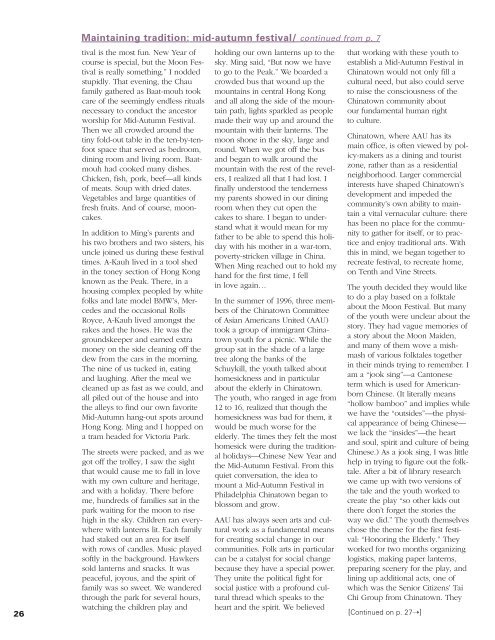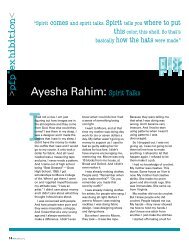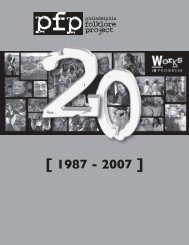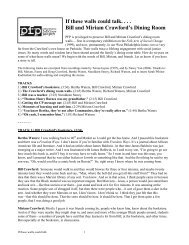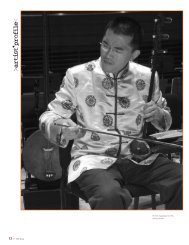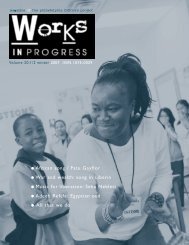View PDF - Philadelphia Folklore Project
View PDF - Philadelphia Folklore Project
View PDF - Philadelphia Folklore Project
You also want an ePaper? Increase the reach of your titles
YUMPU automatically turns print PDFs into web optimized ePapers that Google loves.
26Maintaining tradition: mid-autumn festival/ continued from p. 7 Maintaining tradition: mid-autumn festival/ continued from p. 26tival is the most fun. New Year ofcourse is special, but the Moon Festivalis really something.” I noddedstupidly. That evening, the Chaufamily gathered as Baat-mouh tookcare of the seemingly endless ritualsnecessary to conduct the ancestorworship for Mid-Autumn Festival.Then we all crowded around thetiny fold-out table in the ten-by-tenfootspace that served as bedroom,dining room and living room. Baatmouhhad cooked many dishes.Chicken, fish, pork, beef—all kindsof meats. Soup with dried dates.Vegetables and large quantities offresh fruits. And of course, mooncakes.In addition to Ming’s parents andhis two brothers and two sisters, hisuncle joined us during these festivaltimes. A-Kauh lived in a tool shedin the toney section of Hong Kongknown as the Peak. There, in ahousing complex peopled by whitefolks and late model BMW’s, Mercedesand the occasional RollsRoyce, A-Kauh lived amongst therakes and the hoses. He was thegroundskeeper and earned extramoney on the side cleaning off thedew from the cars in the morning.The nine of us tucked in, eatingand laughing. After the meal wecleaned up as fast as we could, andall piled out of the house and intothe alleys to find our own favoriteMid-Autumn hang-out spots aroundHong Kong. Ming and I hopped ona tram headed for Victoria Park.The streets were packed, and as wegot off the trolley, I saw the sightthat would cause me to fall in lovewith my own culture and heritage,and with a holiday. There beforeme, hundreds of families sat in thepark waiting for the moon to risehigh in the sky. Children ran everywherewith lanterns lit. Each familyhad staked out an area for itselfwith rows of candles. Music playedsoftly in the background. Hawkerssold lanterns and snacks. It waspeaceful, joyous, and the spirit offamily was so sweet. We wanderedthrough the park for several hours,watching the children play andholding our own lanterns up to thesky. Ming said, “But now we haveto go to the Peak.” We boarded acrowded bus that wound up themountains in central Hong Kongand all along the side of the mountainpath, lights sparkled as peoplemade their way up and around themountain with their lanterns. Themoon shone in the sky, large andround. When we got off the busand began to walk around themountain with the rest of the revelers,I realized all that I had lost. Ifinally understood the tendernessmy parents showed in our diningroom when they cut open thecakes to share. I began to understandwhat it would mean for myfather to be able to spend this holidaywith his mother in a war-torn,poverty-stricken village in China.When Ming reached out to hold myhand for the first time, I fellin love again…In the summer of 1996, three membersof the Chinatown Committeeof Asian Americans United (AAU)took a group of immigrant Chinatownyouth for a picnic. While thegroup sat in the shade of a largetree along the banks of theSchuykill, the youth talked abouthomesickness and in particularabout the elderly in Chinatown.The youth, who ranged in age from12 to 16, realized that though thehomesickness was bad for them, itwould be much worse for theelderly. The times they felt the mosthomesick were during the traditionalholidays—Chinese New Year andthe Mid-Autumn Festival. From thisquiet conversation, the idea tomount a Mid-Autumn Festival in<strong>Philadelphia</strong> Chinatown began toblossom and grow.AAU has always seen arts and culturalwork as a fundamental meansfor creating social change in ourcommunities. Folk arts in particularcan be a catalyst for social changebecause they have a special power.They unite the political fight forsocial justice with a profound culturalthread which speaks to theheart and the spirit. We believedthat working with these youth toestablish a Mid-Autumn Festival inChinatown would not only fill acultural need, but also could serveto raise the consciousness of theChinatown community aboutour fundamental human rightto culture.Chinatown, where AAU has itsmain office, is often viewed by policy-makersas a dining and touristzone, rather than as a residentialneighborhood. Larger commercialinterests have shaped Chinatown’sdevelopment and impeded thecommunity’s own ability to maintaina vital vernacular culture: therehas been no place for the communityto gather for itself, or to practiceand enjoy traditional arts. Withthis in mind, we began together torecreate festival, to recreate home,on Tenth and Vine Streets.The youth decided they would liketo do a play based on a folktaleabout the Moon Festival. But manyof the youth were unclear about thestory. They had vague memories ofa story about the Moon Maiden,and many of them wove a mishmashof various folktales togetherin their minds trying to remember. Iam a “jook sing”—a Cantoneseterm which is used for AmericanbornChinese. (It literally means“hollow bamboo” and implies whilewe have the “outsides”—the physicalappearance of being Chinese—we lack the “insides”—the heartand soul, spirit and culture of beingChinese.) As a jook sing, I was littlehelp in trying to figure out the folktale.After a bit of library researchwe came up with two versions ofthe tale and the youth worked tocreate the play “so other kids outthere don’t forget the stories theway we did.” The youth themselveschose the theme for the first festival:“Honoring the Elderly.” Theyworked for two months organizinglogistics, making paper lanterns,preparing scenery for the play, andlining up additional acts, one ofwhich was the Senior Citizens’ TaiChi Group from Chinatown. Theythought perhaps one hundred peoplemight come to see their festival,but were really not sure who mightattend.On that cool fall evening four yearsago, over 450 people from the communityshowed up in the playgroundof Holy Redeemer for thefirst Mid-Autumn Festival. By lastyear, the attendance had risen toover 600. This year, as we preparedfor the fourth festival, we realizedthat many of the youth involvedwith the first play had moved on.They now have jobs and greaterfamily responsibilities. Some havemoved out from the community insearch of more affordable, decenthousing than what is available in thecramped confines of Chinatown. Anew group of youth have begun towork on carrying out the festival.Some of them, like me, cannot reador write Chinese well. We sat withChinese song sheets written outphonetically and prepared songs inMandarin and Cantonese for a singalong.Other youth and elders toldLa Virgen de Guadalupe and Struggles for Justice in Chester County/continued from p. 9wages, health benefits,and work conditions. Inthe KWU’s office, workersregularly meet notonly to talk about strategiesbut also to converseabout their hopes for thefuture and their experiencesas migrants. Imagesof La Virgen deGuadalupe, which adornthe walls of the office,serve as reminders of Herpresence. At the 1994Mushroom Festival agiant mushroom walkedthrough the crowds, participatedin the parade,and oversaw the mushroompicking contest.The mushroom symbolizedthe power of thiscommodity for the economicwell-being of theregion and the vitality ofthe community. For Mexicanworkers, the presenceof La Virgen in theFestival represented analternative sense of communityand well-beingthat went beyond economicconsiderations. InFolk Arts of Social Change: Curator’s Selection/ continued from p. 24Court on issues involvingthe contractors andthe contractors association,and that case didn’titself end until late 1989.it was during the courseof that case that I got anumber of threats onmy own life and whichled me to believe that Imust be doing somethingright if someonefelt that I ought to bethreatened.”—Harold Goodmanfolks at <strong>Philadelphia</strong>Council of NeighborhoodOrganizations ona housing survey of landspeculation in North<strong>Philadelphia</strong>… I did titlesearches on entireblocks. And they wereall controlled by four orfive individuals. Big timespeculators, slum lordsus what the songs mean. Danceswere practiced in one end of theoffice space. The planning committeehas grown and includes youthand elderly. We still search for waysto offer young people access to folkdance and singing traditions in aconsistent way. The festival hasbecome a reason to celebrate, andas such, has become a reason todevelop craft and technique. It hasalso become a vehicle for understandingthe dynamic nature of tradition.It was only after we mountedthe festival in Chinatown that Ilearned from my father that thelanterns which were so precious apart of the festival in Hong Kongand in Chinatown were never a partof Mid-Autumn Festivities in northernChina where he grew up. What Ihad assumed to be a ubiquitous partof the festival turned out to be “asouthern thing.” And of course, theannual Mooncake Eating Contestand the Chinatown Macarena Dancewhich has come to mark one of thefinales of the festival are pure homegrown<strong>Philadelphia</strong> traditions. Andso it goes. Each new idea forreclaiming culture has become acomplex, multilayered adventure.On September 25, 1999, AAU sponsoredthe fourth Mid-Autumn Festivalcelebration in Chinatown. Mychildren, and the others who came,learned the story of Houyi andChang E. They saw mooncakes notas the weird heavy cakes in thecardboard box, but as “the specialtreat we get to eat once a year.”They lit their lanterns and ran withtheir friends through the playgroundat Holy Redeemer. They built memoriesof a sacred, spiritual link tothousands of years of Chinese culture.My father and the other elderswho attended remembered theirchildhood in China. This year, underthe full moon, my husband and Icelebrated the twentieth anniversaryof our “first date”—and I will fell inlove all over again…–Deborah Weithe United States, Mexicanmigrant workers havemaintained their devotionto La Virgen to expresstheir search and demandsfor dignity, justice andbelonging.–Miguel Díaz-Barrigaand Luis Tlasecagiving a crap, tax delinquent…And we weretrying to figure out, howdo we make a pointabout this? ‘Cause allthese people were taxdelinquent. They owedall these back taxes,which were funding forthe schools! Right?… ButBut at a tremendousprice for people whowere willing to be, ineffect, the lead plaintiffsand to stand up and tohow do you package[Continued on p. 27➝] do the right thing. And “I decided to work with sitting on property, not [Continued on p. 28 ➝]27


